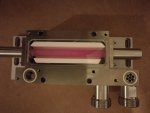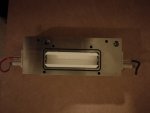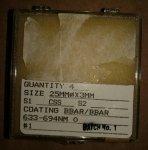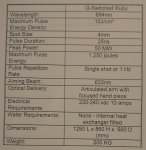I saw this for sale on Ebay and jumped in as I have not seen one before. And going on the price I have seen for Nd-Yag heads this was a very good price.
I have ended up with the Head including the Ruby Rod, Flash Tube and Pump Chamber. This is a water cooled pump chamber. The water actually fully surrounds the Ruby Rod and Flash tube. In direct contact with both.
The Ruby Rod looks in perfect condition. The Flash tube installed shows some minor pitting on the Cathode. The chamber looks in very good condition.
The Ruby Rod and Flash tube are approx 95 mm in length. (Active Area).
Also supplied were 2 brand new flash tubes. Unopened in the original packaging.
3 Focus Mirrors in original packaging. I am not sure if these will be useful. Looking thru them they don't seem to have any noticeable focal length. They seem to be more like OC mirrors. But in the manual they are installed in the Hand piece and called focus mirrors.
Operation manual as well as a service manual. The service manual is pretty simple. No real details about the electronics in the unit.
Also supplied were a Pair of Lambda 694nm Glasses. Some fittings for the hand piece and about 6 glass tubes. I guess they were part of the hand piece.
The laser was built in 1994. Looking at the specs it was a pretty high power tattoo removal laser. It was a Q Switched laser which increases the Pulse power significantly and reduces pulse time.
The Specs for the beam are posted in one of the photos. At a 25 nS pulse it peaks with a 50 Mega Watt Pulse......
Now the hard part begins. I need the HR and OC Mirrors for a Ruby laser. They are getting pretty rare now. I have read on one of the Home Built laser sight that 1064 nm Mirrors can be used. Just not the full output power.
Building the driver for the flash tube wont be a problem for me. I just have to decide how much Energy to pump into the Tube and do the calcs I found in a document online. Voltage, Capacitance and Inductor calculations. I will look at the graph and based on the dimensions of the tube what the explosion energy is and keep under that. Although, being water cooled the explosion energy would be much higher.
The Manual does show the tube was run about 1200 Volts. But there is no indication what capacitor value was used. Maybe I will start off low and then increase it.
I don't expect much will happen for some time though. The Mirrors could take some time. I may just get some 1064 nm and see if they work.
Photos of what I have now.
I have ended up with the Head including the Ruby Rod, Flash Tube and Pump Chamber. This is a water cooled pump chamber. The water actually fully surrounds the Ruby Rod and Flash tube. In direct contact with both.
The Ruby Rod looks in perfect condition. The Flash tube installed shows some minor pitting on the Cathode. The chamber looks in very good condition.
The Ruby Rod and Flash tube are approx 95 mm in length. (Active Area).
Also supplied were 2 brand new flash tubes. Unopened in the original packaging.
3 Focus Mirrors in original packaging. I am not sure if these will be useful. Looking thru them they don't seem to have any noticeable focal length. They seem to be more like OC mirrors. But in the manual they are installed in the Hand piece and called focus mirrors.
Operation manual as well as a service manual. The service manual is pretty simple. No real details about the electronics in the unit.
Also supplied were a Pair of Lambda 694nm Glasses. Some fittings for the hand piece and about 6 glass tubes. I guess they were part of the hand piece.
The laser was built in 1994. Looking at the specs it was a pretty high power tattoo removal laser. It was a Q Switched laser which increases the Pulse power significantly and reduces pulse time.
The Specs for the beam are posted in one of the photos. At a 25 nS pulse it peaks with a 50 Mega Watt Pulse......
Now the hard part begins. I need the HR and OC Mirrors for a Ruby laser. They are getting pretty rare now. I have read on one of the Home Built laser sight that 1064 nm Mirrors can be used. Just not the full output power.
Building the driver for the flash tube wont be a problem for me. I just have to decide how much Energy to pump into the Tube and do the calcs I found in a document online. Voltage, Capacitance and Inductor calculations. I will look at the graph and based on the dimensions of the tube what the explosion energy is and keep under that. Although, being water cooled the explosion energy would be much higher.
The Manual does show the tube was run about 1200 Volts. But there is no indication what capacitor value was used. Maybe I will start off low and then increase it.
I don't expect much will happen for some time though. The Mirrors could take some time. I may just get some 1064 nm and see if they work.
Photos of what I have now.








